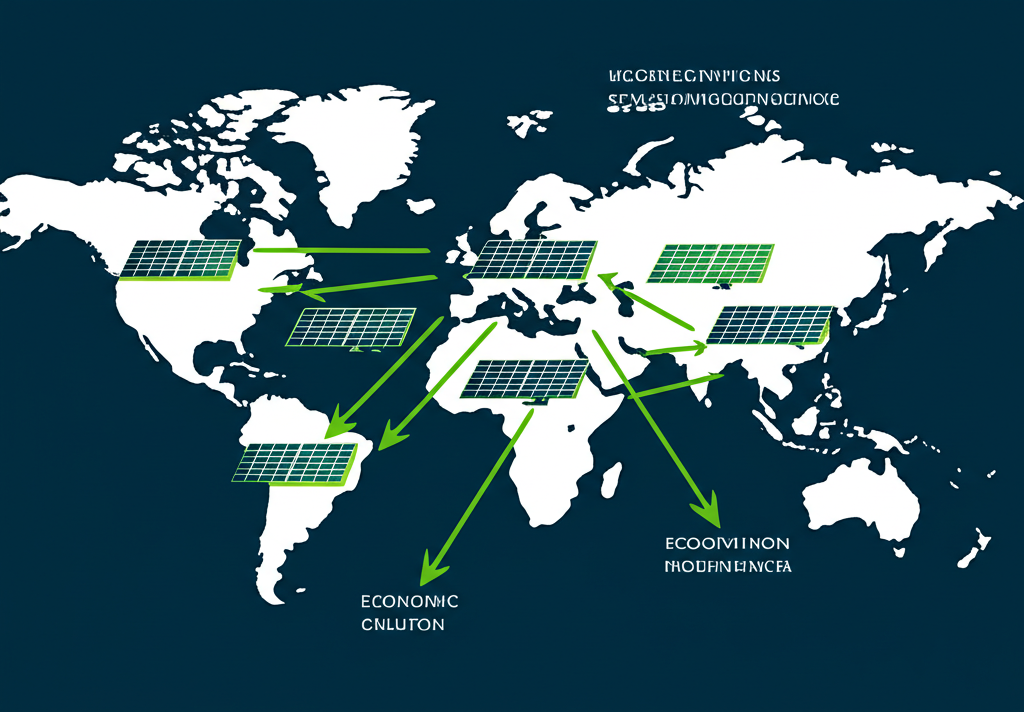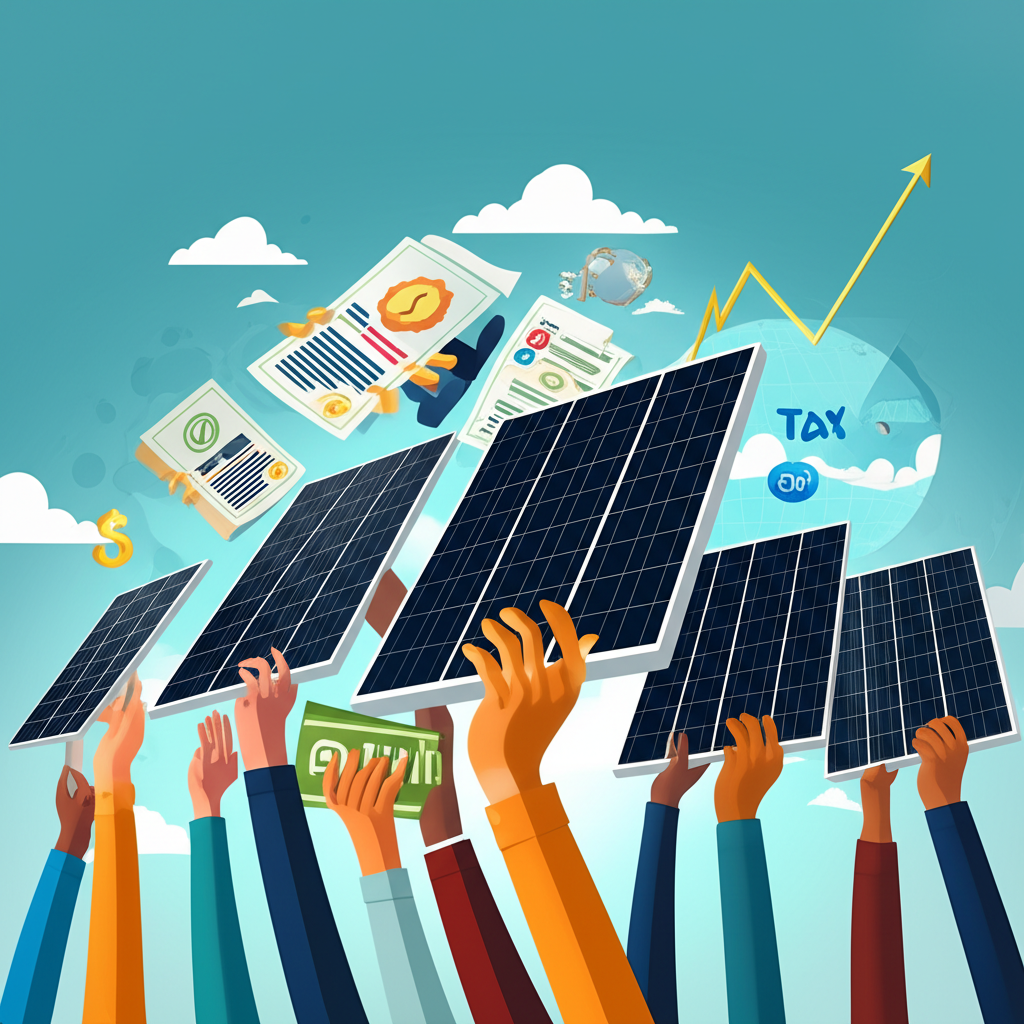Introduction: Harnessing the Power of Solar Stock Investments

Across the world, a profound transformation is reshaping how energy is produced and consumed. As fossil fuels gradually give way to cleaner alternatives, solar power has emerged as a central pillar of this new energy era. Unlike finite resources, sunlight offers an endless supply, positioning solar not just as an environmental imperative but as a powerful engine for long-term financial growth. For investors attuned to macro trends, the accelerating adoption of solar technology presents a rare alignment of purpose and profit. This guide dives deep into the mechanics of investing in solar stocks, unpacking the forces driving the sector, evaluating top players, and offering strategic insights to help both new and seasoned investors make informed decisions. As global demand for clean energy surges, understanding the nuances of solar investing is no longer optional—it’s essential.
Why Invest in Solar Energy? Market Drivers and Growth Potential

Investing in solar energy isn’t just about riding a trend—it’s about positioning capital behind structural shifts that are redefining the global economy. From policy mandates to technological breakthroughs, multiple forces are converging to create a fertile environment for solar companies. The urgency to combat climate change has never been greater, and nations are responding with aggressive decarbonization targets. At the same time, geopolitical tensions and supply chain vulnerabilities have amplified the need for energy independence, pushing governments and businesses toward locally generated, renewable sources. Solar energy, with its declining costs and rapid scalability, stands at the intersection of these powerful currents. For investors, this means access to a market that’s not only expanding but accelerating, offering the potential for outsized returns over time.
The Global Shift to Renewable Energy
Renewable energy is no longer a niche alternative—it’s becoming the default choice for power generation worldwide. Driven by international climate accords like the Paris Agreement and reinforced by national legislation, countries are setting bold goals to phase out coal and gas. Solar energy, in particular, is leading this charge due to its unmatched cost efficiency and ease of deployment. Incentives such as feed-in tariffs, renewable portfolio standards, and tax rebates are further fueling adoption. According to the International Energy Agency (IEA), renewable sources are expected to make up over 90% of new global electricity capacity in the coming five years, with solar accounting for the lion’s share Source: IEA. This isn’t just a policy-driven uptick; it’s a fundamental reordering of the energy ecosystem, creating a durable tailwind for solar equities.
Economic & Environmental Benefits for Investors

The case for solar investment extends well beyond environmental ethics. Economically, solar power has reached a critical tipping point—on a levelized cost basis, it now undercuts fossil fuels in most major markets. This cost advantage translates directly into stronger margins for solar developers and equipment manufacturers, boosting revenue and profitability. At the same time, the rise of ESG (Environmental, Social, and Governance) investing has reshaped capital flows. Institutional investors and asset managers are increasingly allocating funds to companies that demonstrate sustainability leadership. Solar firms, by nature, align with these criteria, often enjoying lower capital costs, stronger public support, and enhanced brand equity. This dual benefit—environmental impact and financial performance—makes solar stocks an increasingly attractive component of modern portfolios.
Understanding the Solar Investment Landscape: Stocks, ETFs, and Beyond

Accessing the solar sector doesn’t require a one-size-fits-all approach. Investors can choose from a spectrum of options, each offering different levels of control, risk, and return potential. Whether you prefer direct ownership of industry leaders, broad diversification through funds, or tangible involvement in clean energy projects, there’s a pathway that fits your strategy. The key is understanding how each method works and how it aligns with your financial objectives. From publicly traded equities to community-based solar programs, the landscape is rich with opportunities for those willing to explore beyond traditional stock picks.
Direct Stock Investment: Picking Individual Solar Companies
Buying shares in individual solar companies allows investors to target specific areas of the value chain—from panel production to project development. This hands-on approach can yield high rewards if you identify a market leader before it gains widespread attention. However, it also exposes you to company-specific risks, such as management missteps, supply chain disruptions, or technological setbacks. Success in this arena demands rigorous research into financial statements, competitive positioning, and long-term vision. Companies like First Solar, Enphase Energy, and SolarEdge have built strong reputations, but even industry frontrunners face challenges in a fast-moving environment. Direct stock investing is best suited for those with the time and expertise to monitor their holdings closely.
Solar ETFs and Mutual Funds: Diversification Made Easy
For investors seeking exposure without the burden of picking winners and losers, solar ETFs and mutual funds offer a smarter, more balanced alternative. These funds bundle dozens of solar-related stocks into a single security, instantly spreading risk across manufacturers, installers, and technology providers. This diversification helps cushion against the volatility often seen in individual names. Moreover, many solar ETFs are actively managed by professionals who track industry trends and rebalance portfolios accordingly. Examples like the Invesco Solar ETF (TAN) and the Global X Solar ETF (RAYS) provide instant access to a broad cross-section of the sector, making them ideal entry points for beginners or those looking to maintain a stable allocation to clean energy.
Beyond Equities: Investing in Physical Solar Assets (A Differentiated View)
While most investors focus on stocks and funds, another layer of opportunity exists in physical solar assets. This includes installing solar panels on your own property, participating in community solar programs, or purchasing solar bonds issued by project developers. Each option provides a tangible connection to clean energy generation. Homeowners with rooftop systems can reduce or even eliminate electricity bills while qualifying for tax incentives. Community solar allows renters or those with shaded roofs to benefit from off-site solar farms through utility bill credits. Solar bonds, meanwhile, offer fixed-income returns backed by the cash flows of operating solar projects. Though less liquid than stocks and often requiring larger upfront commitments, these assets deliver predictable returns and a direct environmental impact, rounding out a holistic investment approach.
Top Solar Stocks to Watch: Key Players and Emerging Innovators
The solar industry is far from monolithic. It’s a dynamic ecosystem made up of established leaders and agile disruptors, each carving out a unique niche. Understanding the different segments—manufacturers, technology providers, and project developers—is crucial for identifying where value is being created. While some companies dominate through scale and reliability, others are pushing boundaries with next-generation innovations. This blend of stability and disruption defines the sector’s appeal, offering opportunities for both conservative and growth-oriented investors.
Leading Manufacturers & Technology Providers
- First Solar (NASDAQ: FSLR): As one of the few major U.S.-based solar panel manufacturers, First Solar stands out for its proprietary cadmium telluride (CadTel) thin-film technology. This approach offers superior performance in high-heat and humid conditions, giving it an edge in utility-scale deployments across the Middle East, India, and the southern United States. With a strong balance sheet and a growing pipeline of domestic manufacturing under the Inflation Reduction Act, First Solar is well-positioned for long-term growth.
- Enphase Energy (NASDAQ: ENPH): A pioneer in microinverter technology, Enphase has become a household name in residential solar. Its systems allow individual solar panels to operate independently, maximizing energy output and simplifying maintenance. Beyond inverters, Enphase has expanded into battery storage and energy management software, creating a seamless ecosystem for homeowners. Its focus on reliability and user experience has earned it a loyal customer base and a dominant market share in North America.
- SolarEdge Technologies (NASDAQ: SEDG): Known for its power optimizers and smart inverters, SolarEdge enhances the efficiency of solar PV systems by enabling panel-level monitoring and optimization. This technology is especially valuable in shaded or complex roof environments. The company has extended its reach into battery storage, EV charging, and commercial solar solutions, building a comprehensive platform that integrates seamlessly with modern energy needs.
Utility-Scale & Residential Installers
While hardware companies get much of the attention, the companies that install and manage solar systems play an equally vital role. Firms like Sunrun and SunPower lead in the residential space, handling everything from customer acquisition to system design and maintenance. On the utility side, traditional energy companies such as NextEra Energy are investing billions in large-scale solar farms, leveraging their infrastructure and regulatory expertise. These installers and developers often operate on thin margins due to high customer acquisition costs, but those with efficient operations and strong financing capabilities can generate consistent returns. Their performance tends to correlate closely with policy incentives and interest rate environments, making them sensitive but strategic plays on solar adoption.
Emerging Technologies & Niche Segments (Differentiation)
Looking beyond the current landscape, the next wave of solar innovation is already taking shape. Startups and research labs are advancing perovskite solar cells, which promise efficiencies exceeding 30%—a significant leap over traditional silicon panels. Though still in the commercialization phase, this technology could redefine the industry in the coming decade. Similarly, companies focused on solid-state batteries and flow storage are addressing solar’s intermittency challenge, enabling longer-duration energy storage at lower costs. Meanwhile, smart grid startups are developing AI-driven platforms to balance supply and demand across decentralized energy networks. Investing in these niche areas carries higher risk, but the potential rewards are substantial for those who back the right technologies at the right time.
Evaluating Solar Stocks: Crucial Factors for Due Diligence
Not all solar stocks are created equal. With so many companies vying for market share, identifying those with sustainable advantages requires a disciplined evaluation process. While the sector’s overall trajectory is positive, individual performance can vary dramatically based on execution, innovation, and external dependencies. Investors must go beyond headlines and examine the underlying fundamentals that drive long-term value creation. A holistic analysis should include financial health, technological edge, policy exposure, and operational resilience.
Financial Health and Valuation Metrics
A company’s financial strength is the foundation of any sound investment. Key indicators include consistent revenue growth, improving operating margins, and manageable debt levels. While rapid expansion often leads to short-term losses, especially in capital-intensive sectors, the path to profitability matters. Investors should also assess cash flow generation—strong operating cash flow enables reinvestment in R&D and expansion without excessive borrowing. Valuation metrics like the Price-to-Sales (P/S) ratio and Enterprise Value to EBITDA help determine whether a stock is overvalued relative to its growth potential. Comparing these figures across peers provides context and helps avoid overpaying for momentum.
Technological Innovation & Competitive Advantage
Innovation is the lifeblood of the solar industry. Companies that consistently improve efficiency, reduce costs, or integrate new capabilities—such as storage or smart controls—gain a lasting edge. Patents, proprietary manufacturing processes, and strong R&D pipelines serve as moats against competitors. For example, First Solar’s CadTel technology and Enphase’s software ecosystem are not easily replicated. Equally important is brand reputation and customer trust, particularly in the residential market where word-of-mouth and service quality influence buying decisions. A company that combines technological leadership with customer loyalty is more likely to sustain its position as the market evolves.
Policy & Regulatory Environment
No discussion of solar investing is complete without addressing policy risk. Government incentives—such as the U.S. Investment Tax Credit (ITC) or the Inflation Reduction Act (IRA)—have been instrumental in driving demand and improving project economics Source: The White House. However, these benefits can change with political shifts. Tariffs on imported solar components, changes in net metering rules, or delays in permitting can all impact profitability. Savvy investors monitor legislative developments in key markets like the U.S., EU, China, and India, assessing how policy changes might affect revenue streams and project timelines. Companies with diversified geographic exposure or those benefiting from domestic manufacturing incentives are better insulated from regulatory shocks.
Supply Chain Resilience & Geographic Diversification
The solar industry relies on a complex web of suppliers, from polysilicon producers to glass and aluminum manufacturers. Historically, much of this supply chain has been concentrated in China, creating vulnerabilities. Trade disputes, shipping delays, or geopolitical tensions can disrupt production and inflate costs. Companies that have diversified their sourcing, invested in local manufacturing, or secured long-term supply agreements are more resilient. Similarly, geographic diversification in sales markets—operating across North America, Europe, and emerging regions—reduces dependence on any single economy or regulatory framework. This global footprint not only mitigates risk but also captures growth from regions with rising energy demand.
Navigating the Risks: Challenges and Volatility in Solar Investing
Despite its bright long-term outlook, the solar sector is not without turbulence. Investors should expect periods of sharp volatility, driven by factors beyond fundamental performance. Recognizing these risks upfront allows for better portfolio management and more realistic expectations. While the macro trends favor solar, short-term headwinds can create significant drawdowns, particularly for leveraged or speculative names.
Market Volatility & Cyclicality
Solar stocks have a history of boom-bust cycles, often tied to supply-demand imbalances. Rapid expansion can lead to overcapacity, triggering price wars among manufacturers. These dynamics, combined with high capital requirements and long project timelines, contribute to earnings volatility. Additionally, solar equities often trade in tandem with broader growth stocks, making them susceptible to interest rate shifts. When rates rise, future cash flows are discounted more heavily, impacting valuations. As a result, even fundamentally strong companies can see their stock prices swing dramatically in response to macroeconomic sentiment.
Policy & Regulatory Uncertainty
Government support has been a major catalyst for solar growth, but it also introduces a key vulnerability. Changes in tax incentives, import tariffs, or renewable energy mandates can alter the economics of solar projects overnight. For example, the expiration or reduction of the ITC in the U.S. could dampen residential and commercial adoption. Similarly, trade actions like anti-dumping duties on Chinese solar imports can increase costs for developers reliant on foreign panels. Political transitions or shifts in energy priorities can also lead to policy reversals, making regulatory monitoring a critical part of solar investing.
Intense Competition & Technological Obsolescence
The barriers to entry in solar manufacturing have decreased over time, leading to fierce competition. With dozens of panel makers worldwide, price competition is relentless, squeezing margins. At the same time, technological progress moves quickly. A breakthrough in cell efficiency or manufacturing technique can render existing products obsolete. Companies that fail to innovate risk being left behind. This rapid pace demands continuous investment in R&D, which smaller firms may struggle to afford. As a result, only those with strong balance sheets and visionary leadership are likely to maintain a competitive edge over the long term.
Supply Chain Dependencies & Geopolitical Risks
Many solar companies depend on raw materials and components sourced from specific regions. For instance, a significant portion of the world’s polysilicon comes from Xinjiang, China, creating ethical and logistical concerns. Trade restrictions, human rights investigations, or regional instability can disrupt supply lines and increase costs. Similarly, shipping bottlenecks or port closures can delay project timelines. Investors should evaluate how dependent a company is on single-source suppliers and whether it has contingency plans in place. Firms with vertical integration, local production, or multi-regional sourcing are better equipped to navigate these challenges.
Strategic Approaches for Investing in Solar Stocks
Success in solar investing isn’t just about picking the right stocks—it’s about applying the right strategy. Your approach should reflect your risk tolerance, time horizon, and overall financial goals. Whether you’re building a long-term portfolio or seeking tactical opportunities, a structured framework can help you stay disciplined amid market noise.
Long-Term vs. Short-Term Strategies
Given the structural tailwinds behind renewable energy, a long-term buy-and-hold strategy often makes the most sense for solar investments. This approach allows you to benefit from the compounding effects of industry growth while smoothing out short-term volatility. Companies that innovate and scale effectively can deliver exponential returns over a decade or more. In contrast, short-term trading strategies—such as swing trading or momentum plays—require constant monitoring and carry higher risk. While they can yield quick gains, they also expose investors to timing errors and emotional decision-making. For most, patience and conviction are more rewarding than frequent trading.
Portfolio Diversification with Solar Exposure
Solar should be one component of a well-balanced portfolio, not the entirety of it. Even with strong conviction in the sector, overconcentration increases risk. A smarter approach is to allocate a portion of your equity exposure to solar—either through individual stocks or ETFs—while maintaining diversification across other sectors like healthcare, technology, and consumer goods. Within the solar space itself, spreading investments across manufacturers, installers, and technology providers reduces reliance on any single business model. Solar ETFs are particularly effective for achieving this diversification with minimal effort.
Advanced Risk Mitigation & Timing Strategies (Differentiation)
Beyond basic diversification, sophisticated investors can employ additional tactics to manage risk. Dollar-cost averaging (DCA), for example, involves investing a fixed amount at regular intervals, reducing the impact of market swings and eliminating the need to time the market. Monitoring policy cycles—such as upcoming legislative debates or subsidy renewal dates—can also inform entry and exit points. Some investors use options strategies, like buying protective puts, to hedge against downside risk in volatile names. While these techniques require deeper knowledge, they can enhance risk-adjusted returns. Additionally, tracking commodity prices—such as polysilicon or silver—can provide early signals about future margin trends for manufacturers, aiding in more informed decision-making.
The Future of Solar: What’s Next for the Industry and Investors
The solar revolution is far from over. As technology advances and adoption broadens, new opportunities are emerging across the energy landscape. The next phase will be defined not just by more panels, but by smarter integration, deeper storage, and wider applications. Investors who understand these shifts will be best positioned to capture the next wave of growth.
Integration with Energy Storage and Smart Grids
Solar’s biggest limitation—its intermittency—is being solved by advances in energy storage. Battery systems, from residential units like the Tesla Powerwall to grid-scale installations, are making solar a dispatchable power source. The convergence of solar and storage is creating a new category of companies offering turnkey energy solutions. Beyond batteries, smart grid technologies are enabling real-time optimization of energy flows, allowing utilities to balance supply and demand more efficiently. Firms that specialize in grid software, demand response, or hybrid power plants are likely to see increasing demand as grids modernize.
Emerging Markets and New Applications
While the U.S. and Europe have led the solar transition, the next frontier lies in emerging markets. Countries in Southeast Asia, Africa, and Latin America are experiencing rapid electrification and urbanization, creating massive demand for affordable, scalable energy. Solar, especially in off-grid and mini-grid configurations, is often the most practical solution. New applications are also expanding the market—floating solar farms on reservoirs, solar-powered EV charging stations, and building-integrated photovoltaics (BIPV) that turn windows and facades into energy generators. These innovations are not only pushing efficiency boundaries but opening entirely new revenue streams for forward-thinking companies.
Conclusion: Shining a Light on Your Solar Investment Journey
Investing in solar stocks offers a unique opportunity to align financial goals with planetary priorities. Supported by global decarbonization efforts, falling costs, and technological innovation, the sector is poised for sustained expansion. Yet, it’s not without challenges—volatility, policy shifts, and fierce competition require careful navigation. By focusing on financial strength, technological leadership, and strategic diversification, investors can build resilient portfolios positioned to benefit from the clean energy transition. Whether through individual equities, diversified funds, or physical assets, a thoughtful approach to solar investing can illuminate a path toward both sustainability and long-term wealth creation.
Are solar stocks a good investment for the long term?
Yes, the long-term outlook for solar stocks is generally positive due to global decarbonization efforts, decreasing costs of solar technology, and increasing energy demand. However, investors should be prepared for short-term volatility and perform thorough research.
What is the best solar stock to buy for beginners?
For beginners, investing in a diversified solar ETF (Exchange Traded Fund) like the Invesco Solar ETF (TAN) or the Global X Solar ETF (RAYS) is often recommended. This approach offers exposure to a basket of solar companies, reducing the risk associated with picking individual stocks.
How can I invest in solar energy without buying individual stocks?
You can invest in solar energy through several avenues without buying individual stocks:
- Solar ETFs or Mutual Funds: Offer diversified exposure to the solar sector.
- Green Bonds/Solar Bonds: Debt instruments issued by solar project developers.
- Community Solar Programs: Allow participation in local solar projects, earning credits on electricity bills.
- Direct Physical Assets: Installing solar panels on your own property.
What are the biggest risks associated with investing in solar stocks?
Key risks include:
- Market Volatility: Price fluctuations due to oversupply or demand shifts.
- Policy and Regulatory Changes: Shifts in government incentives or trade tariffs.
- Intense Competition: Leading to price wars and margin compression.
- Technological Obsolescence: Rapid advancements making current tech outdated.
- Supply Chain Dependencies: Reliance on specific regions for raw materials.
Will government policies impact solar stock performance?
Yes, government policies have a significant impact on solar stock performance. Incentives like tax credits and subsidies can boost demand and profitability, while unfavorable policy changes, such as tariff increases or reduced subsidies, can negatively affect the industry and stock valuations.
How do I research solar companies before investing?
To research solar companies, focus on:
- Financial Health: Revenue growth, profitability, debt levels, cash flow.
- Technological Innovation: R&D investments, proprietary technologies.
- Competitive Advantage: Market share, brand strength.
- Management Team: Experience and track record.
- Policy Exposure: How heavily the company relies on government incentives.
- Supply Chain: Diversification and resilience.
What is the difference between investing in solar manufacturing vs. installation companies?
Manufacturing companies (e.g., First Solar) produce solar panels, inverters, and other components. Their performance is tied to production capacity, technological innovation, and raw material costs. Installation companies focus on designing, deploying, and maintaining solar projects for residential, commercial, or utility-scale clients. Their success often depends on project pipelines, customer acquisition, and operational efficiency.
Are there any tax benefits for investing in solar energy?
Tax benefits vary by country and region. In the U.S., for example, homeowners installing solar panels may qualify for federal tax credits. Some investments in solar projects or companies might also qualify for specific clean energy investment tax incentives. It’s advisable to consult a financial advisor or tax professional for personalized information.
Why are some solar stocks experiencing high volatility?
High volatility in solar stocks can be attributed to several factors: the industry’s rapid growth phase, sensitivity to government policies, commodity price fluctuations, intense competition, and the capital-intensive nature of project development. Geopolitical events and broader market sentiment also play a role.
What role does energy storage play in the future of solar stock investments?
Energy storage, particularly battery technology, is crucial for the future of solar. It addresses the intermittency of solar power, making it a more reliable and dispatchable energy source. Companies involved in advanced battery manufacturing, integrated solar-plus-storage solutions, or smart grid technologies that optimize energy storage are expected to see significant growth and offer compelling investment opportunities.

留言